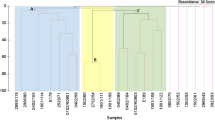Abstract
About 700 limicolous and 100 true marine species are known so far. The passive ways of their distribution are more important than active migration. Watersheds and the current are the main mechanical barriers while salinity, oxygen content and temperature of the water are the ecological ones. Most of the species need hibernation in cold for successful sexual reproduction and therefore cannot colonize the torrid zone. Only 4.5% of the species (most of them antropochorous) are cosmopolitan while 72% are distributed in one region or subregion only, and 42% are known from a single locality. Nine of the 15 families surely originate from the northern temperate zone. Probably the class arose from its polychaete ancestors in marsh biotopes and differentiated during the dry and cold Perm period, which may be reflected in the thermophobe character of their sexual reproduction. After the dissociation of Pangaea, the ranges of families were distributed between the new continents. The evolution of some groups became quicker in the Pleistocene again.
The inland waters are divided by the author into 6 zoogeographical regions, some of them into subregions. There are some subfamilies, genera and separate species secondarily and independently adapted to marine life. An attempt is made to describe the changes in the limicolous oligochaete fauna of the northwestern part of the Soviet Union in the Holocene.
About 1,300 species of aquatic oligochaetes in the wider meaning of the word (including Aeolosomatidae and Branchiobdellidae) have been observed. Discarding amphibious forms and those casually fallen into water or those populating only the sea littoral (from among the Enchytraeidae and Megadrili), about 700 limicolous and 100 genuine marine species remain. During the recent decades, abundant data from all over the world became available on their distribution. Contours of regional peculiarities are appearing. Therefore it is time to sum up the data on the zoogeography of aquatic oligochaetes.
The material of the present report includes the distribution charts of all known aquatic oligochaetes drawn on the basis of data from literature and the samples collected by the author from the water bodies of the north-western part of the Soviet Union.
Access this chapter
Tax calculation will be finalised at checkout
Purchases are for personal use only
Preview
Unable to display preview. Download preview PDF.
Similar content being viewed by others
References
Benham, W.B., 1903, A Note on the Oligochaeta of the New Zealand Lakes. Trans. Proc. N.Z. Inst., 36:192–198.
Bretscher, K., 1903, Tiergeographisches uber die Oligochaten. Biol. Centralblatt, 23:618–625.
Brinkhurst, R.O. and B.G.M. Jamieson, 1971, Aquatic Oligochaeta of the World. Edinburgh, 860 p.
Cekanovskaja, O.V., 1962, The Aquatic Oligochaeta of the USSR. (In Russian). Moskva-Leningrad, 411 p.
Gates, G.E., 1958, Contribution to a Revision of the Earthworm Family Lumbricidae. II. Indian Species. Breviora Mus. Comp. Zool., 91:1–16.
Izossimov, V.V., 1962, Oligochaetes of the Family Lumbriculidae (in Russian). Trudy Limnol. Inst., 1:3–126.
Jarvekulg, A., 1957, Uber das Vorkommen der Krebskiemenegel (Gattung Branchiobdella Odier) als Parasiten des Edelkrebses (Astacus astacus (L.), in Estland. (In Estonian). Eesti NSV Tead. Akad. Loodusuurijate Seltsi Aastaraamat, 50:249–256.
Michaelsen, W., 1903, Die geographische Verbreitung der Oligochaeten. Berlin, 187 S.
Minina, N.G., 1975, On the Horizontal Distribution of the Zoobenthos in the Lake Pskovsko-Chudskoje.(In Russian). Trudy Pskov. otd. GosNIORH, 1:75–83.
Omodeo, P., 1963, Distribution of the Terricolous Oligochaetes on the Two Shores of the Atlantic. North Atlantic Biota and Their History. Oxford-London-N.Y.-Paris, 127–151.
Starobogatov, J.I., 1970, Fauna of Mollusca and the Zoogeographical Division of the Continental Water Bodies. (In Russian). Leningrad, 372 p.
Stephenson, J., 1930, The Oligochaeta. Oxford, 978 p.
Zacharias, O., 1889, Ueber Anpassungserscheinungen im Hinblick auf passive Migration. Biol. Centralblatt, 9:107-113
Author information
Authors and Affiliations
Editor information
Editors and Affiliations
Rights and permissions
Copyright information
© 1980 Plenum Press, New York
About this chapter
Cite this chapter
Timm, T. (1980). Distribution of Aquatic Oligochaetes. In: Brinkhurst, R.O., Cook, D.G. (eds) Aquatic Oligochaete Biology. Springer, Boston, MA. https://doi.org/10.1007/978-1-4613-3048-6_6
Download citation
DOI: https://doi.org/10.1007/978-1-4613-3048-6_6
Publisher Name: Springer, Boston, MA
Print ISBN: 978-1-4613-3050-9
Online ISBN: 978-1-4613-3048-6
eBook Packages: Springer Book Archive



